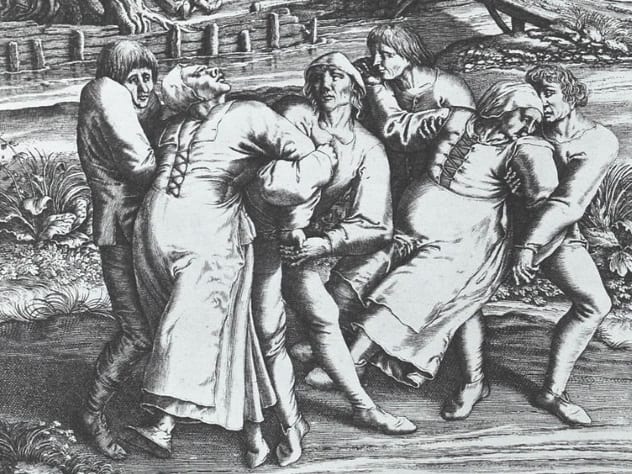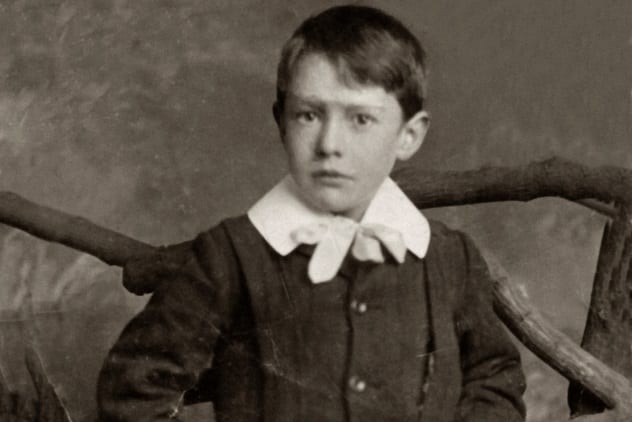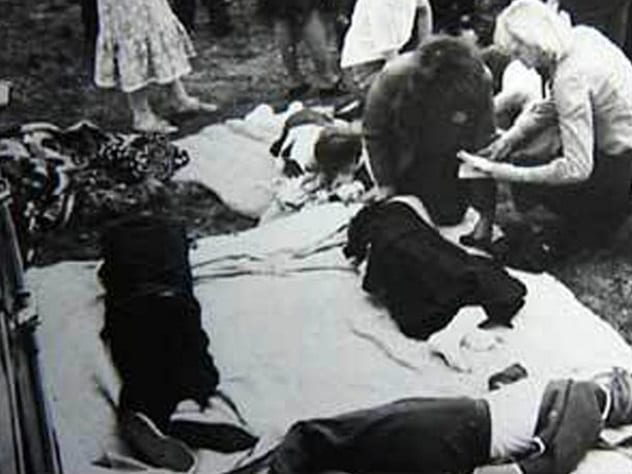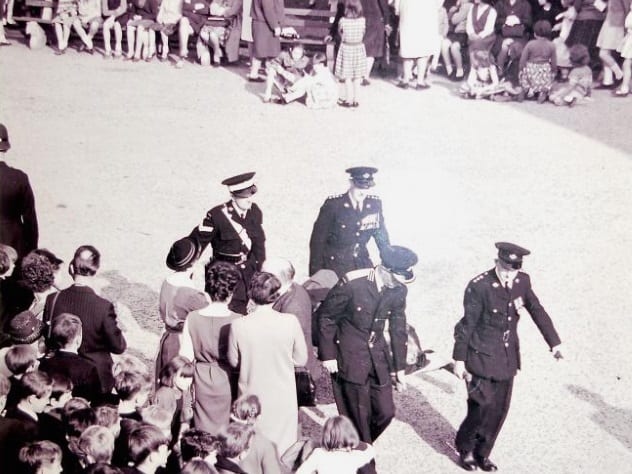 Our World
Our World  Our World
Our World  Movies and TV
Movies and TV The 10 Coolest Stars to Set Sail on The Love Boat
 History
History 10 Things You Didn’t Know About the American National Anthem
 Technology
Technology Top 10 Everyday Tech Buzzwords That Hide a Darker Past
 Humans
Humans 10 Everyday Human Behaviors That Are Actually Survival Instincts
 Animals
Animals 10 Animals That Humiliated and Harmed Historical Leaders
 History
History 10 Most Influential Protests in Modern History
 Creepy
Creepy 10 More Representations of Death from Myth, Legend, and Folktale
 Technology
Technology 10 Scientific Breakthroughs of 2025 That’ll Change Everything
 Our World
Our World 10 Ways Icelandic Culture Makes Other Countries Look Boring
 Our World
Our World 10 Ways Your Christmas Tree Is More Lit Than You Think
 Movies and TV
Movies and TV The 10 Coolest Stars to Set Sail on The Love Boat
 History
History 10 Things You Didn’t Know About the American National Anthem
Who's Behind Listverse?

Jamie Frater
Head Editor
Jamie founded Listverse due to an insatiable desire to share fascinating, obscure, and bizarre facts. He has been a guest speaker on numerous national radio and television stations and is a five time published author.
More About Us Technology
Technology Top 10 Everyday Tech Buzzwords That Hide a Darker Past
 Humans
Humans 10 Everyday Human Behaviors That Are Actually Survival Instincts
 Animals
Animals 10 Animals That Humiliated and Harmed Historical Leaders
 History
History 10 Most Influential Protests in Modern History
 Creepy
Creepy 10 More Representations of Death from Myth, Legend, and Folktale
 Technology
Technology 10 Scientific Breakthroughs of 2025 That’ll Change Everything
 Our World
Our World 10 Ways Icelandic Culture Makes Other Countries Look Boring
10 Epidemics Of Mass Hysteria
Mass hysteria is a psychological phenomenon which has been documented since the Middle Ages. Political turmoil, environmental stress, fear of the unknown, and the need for social acceptance from our peers can often cause us to behave in an irrational manner, and throughout history, close-knit groups, such as schools and small communities, have experienced inexplicable episodes of mass hysteria.
SEE ALSO: Top 10 Bizarre Cases of Mass Hysteria
Many times, a single unusual incident with a logical explanation has escalated into an epidemic in which those close by imagine they are experiencing similar symptoms. From bizarre behavior to imaginary illnesses, there have been a number of epidemics of mass hysteria throughout history.
10 Dancing Plague Of 1518

We’ve all been tempted to “dance till you drop” when out partying or clubbing. But during the Middle Ages, residents of a French town actually died from dancing.[1]
In 1518, a case of dancing plague broke out in Strasbourg, in the French Alsace region. Starting with one lone dancer, the footloose outbreak led to over 400 people eventually taking to the streets, dancing nonstop for days on end. Many collapsed from exhaustion, some apparently dying from heart attack or stroke. The Dancing Plague lasted for over a month. Those affected were predominantly female. Few historic notes exist to document the exact cause of the plague.
Town leaders were highly unamused with the ongoing displays of frenetic dancing. Learned physicians at the time suggested that the cause was “overheated blood” in the brain during the hot July days. It has been more recently suggested that a fungus, ergot, in the wheat fields (and thus in people’s bread) may have been the cause. The ergot would have produced reactions similar to LSD.
9 Tanganyika Laughing Epidemic

In 1962, three students at a boarding school in Tanganyika (modern-day Tanzania) began laughing uncontrollably. Their laughter was contagious and soon spread to 95 students at the school.
Bouts of uncontrolled hysteria lasted from a few hours to more than two weeks. Victims also experienced bouts of crying, pain, and fainting. Teachers were unable to conduct lessons with the bouts of hysterical laughing, and the school was forced to shut down for two months while the epidemic was brought under control.
However, the hysteria reportedly spread to surrounding villages and to a number of surrounding schools. Altogether, over 1,000 people were affected.[2]
Possible toxins from contaminated food or chemicals were ruled out as a cause of the epidemic. No definite medical cause could be found for the laughing disease, which was blamed on the stress of the strict boarding school regime.
8 Mad Gasser

During World War II, residents of the town of Mattoon, Illinois, became convinced they were under attack from a phantom anesthetist who was attempting to gas them as they slept. Victims complained of a strange odor in their homes before being struck with symptoms ranging from paralysis to coughing, nausea, and vomiting.[3]
The first report came at the end of August 1944, when a resident awoke to a strange smell and suffered a fit of nausea and vomiting. His wife was paralyzed and unable to leave her bed. Police received over 20 similar reports of “gassings” over the following two weeks. Panic ensued as the nightly “gassings” became more prevalent, but no firm sighting of a culprit ever occurred.
All victims made complete and speedy recoveries. Investigators explained the incidents as combinations of odors from a nearby industrial plant and mass hysteria in reaction to reports of a nocturnal prowler.
7 Meowing Nuns

Nuns in religious orders across France and Germany went barking mad during the 15th century. During medieval times, many women entered convents against their will, being forced into a life of celibacy and poverty by their parents. They were condemned to a life of austerity and manual labor. So it is probably no surprise that convent life caused some bizarre behavior from the inmates.
In 1491, a nun in a large French convent began meowing like a cat. Her sisters soon followed her in this strange behavior until the convent was overcome with a “cat imitation” plague. The surrounding villagers were disturbed by this daily caterwauling, to the point that a platoon of soldiers were stationed outside the convent. The nuns were told they would be beaten with rods if they continued to meow.
Various nunneries across the region reported similar epidemics of nuns imitating cats, dogs, and birds, as well as biting viciously. At the time, “demonic possession” was the explanation for the epidemics. However, the repressive conditions in which the nuns lived causing a form of mass hysteria is a more likely explanation.[4]
6 Strawberries With Sugar Virus

In 2006, over 300 Portuguese schoolchildren were hit with an unexplained illness. Patients complained of dizziness, breathing difficulties, and rashes. The strange illness only affected schoolchildren and was reported in numerous schools around the country.
A teen soap opera called Strawberries with Sugar was identified as the problem. An episode had aired a few days before the outbreak, in which a strange virus was striking children at the show’s school. Apparently, watching the episode had led to children believing that their everyday ailments or allergies were in fact an outbreak of the deadly virus they had seen on television.[5]
5 Meissen Trembling Disease

Several German schools were hit with an epidemic of trembling in 1905.[6] A student in Meissen began trembling and twitching as she wrote in October of that year. By May the following year, over 200 students at surrounding schools had been afflicted with the unexplained twitching epidemic. The tremors only occurred when the students were given writing tasks and were not present when performing other lessons.
All the students were high performers, indicating that the stress of having to achieve good grades combined with reports of other instances of the trembling disease contributed to the hysteria. Students were “treated” with electric shocks to “cure” the tremors, which soon subsided after a rest from writing.
4 Hollinwell Incident

A swooning epidemic hit a group of schoolchildren in England’s East Midlands in July 1986.
Over 500 schoolchildren had traveled from all around to compete in a marching band competition. All were assembled and ready to perform, when suddenly, they began collapsing. Around 300 children and adults ultimately dropped at the Hollinwell showground. Mass panic erupted, with emergency crews called in to deal with the growing crisis.[7]
Victims later complained of having experienced a sore throat and a burning sensation in the eyes. Initial investigations considered a gas leak or contamination from crop dusting as being possible causes of the mass fainting episode. The incident was officially explained as a form of mass hysteria, caused by a combination of tiredness from a long journey to the contest, the heat of the day, and preperformance jitters.
3 Blackburn Faintings

Schoolchildren in the UK town of Blackburn were hit with a fainting epidemic which lasted several days in 1965.
The fainting frenzy began while people were waiting outside the Blackburn Cathedral for Princess Margaret to arrive to officially open the restorations. An early start to the day, with several hours standing in the sun, were initially blamed when 140 children fainted on the grounds.
However, the following day, another 98 patients were hit with the mysterious fainting epidemic at a nearby school. By the end of the week, over 300 children had been affected.
The schools were closed and carefully inspected for a possible cause, with fumes from a nearby factory initially blamed for the fainting episodes. Mass hysteria, leading to overbreathing, brought on by the excitement of the royal visit was finally declared the cause of the fainting fits.[8]
2 Wurzburg Screaming Epidemic

A nunnery in Wurzburg, Germany, was hit by a screaming epidemic in 1749. As with the meowing nuns a few centuries earlier, it was probably brought on by a combination of boredom and frustration at being forced into a religious life.
The sub-prioress, Sister Maria Renata, initially denied entry into the convent for a young woman who was prone to convulsions. Her decision was overturned, and other sisters within the community began imitating the young woman’s behavior, showing signs of “demonic possession” during services. Victims experienced episodes of screaming, writhing, foaming at the mouth, and entering a trancelike state.
The sub-prioress was coerced into confessing to witchcraft and was beheaded for her crimes against the Church, ending the screaming sessions from the other nuns.
1 Face-Scratcher

In poorly educated communities, villagers will often turn to folklore and mythology to explain the unknown. A belief that aliens were scratching the faces of victims at night sparked mass panic in a town in Uttar Pradesh.
In 2002, residents were reporting a “brightly lit object” that “flies sideways” attacking victims, leaving scratch marks on their faces. Reports ranged from football-sized objects to a UFO the size of a large tortoise that flew at victims, leaving scratches and burn marks.
From an initial isolated incident, rumors of the alien attacker soon spread, sparking widespread panic. Nighttime vigilante groups were set up to scare away the face-scratcher, and residents demanded police capture the extraterrestrial assailants. The only confirmed deaths, however, were from police firing into large crowds to disperse protesters who had gathered to demand action.[10]
Explanations for the phenomenon ranged from an insect plague to “lightning balls” striking victims as they slept outside. The face-scratcher disappeared suddenly once the monsoon season arrived.
Lesley Connor is a retired Australian newspaper editor who contributes articles to online publications and her travel blog.
Read about more bizarre episodes of mass hysteria over the years on 10 Incredibly Insane Cases Of Mass Hysteria and 10 Twisted Facts About The Dancing Plagues.



![11 Lesser-Known Facts About Mass Murderer Jim Jones [Disturbing Content] 11 Lesser-Known Facts About Mass Murderer Jim Jones [Disturbing Content]](https://listverse.com/wp-content/uploads/2020/09/jonestown2-copy-150x150.jpg)